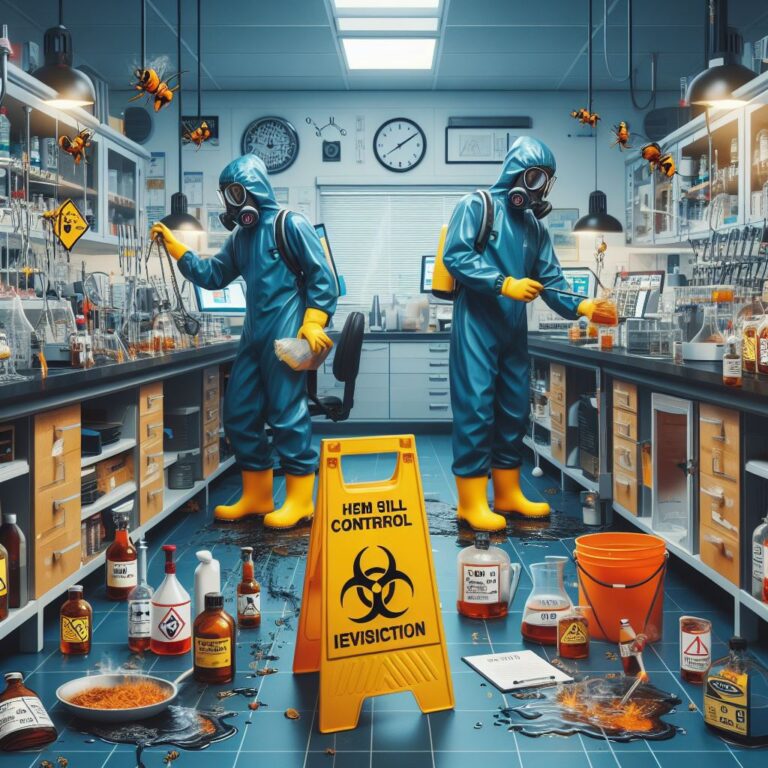Chemical spills can be hazardous to both people and the environment in a laboratory setting. Taking steps to prevent spills and knowing how to respond to them can greatly minimize the risk of harm. In this blog, we will discuss important guidelines for effective chemical spill control to keep you and your colleagues safe.
To purchase the Brady SPC SKA-PP Allwik Universal Economy Portable Spill Kit – 107795 and ensure spill readiness, click here!

1. Introduction
- Definition of chemical spills and their potential hazards.
- Importance of chemical spill control in the laboratory.

Definition of chemical spills and their potential hazards:
Chemical spills occur when a hazardous substance is released in an uncontrolled manner, posing a risk to human health and the environment. Chemical spills can be caused by a variety of factors, including accidents, equipment failure, and human error. The potential hazards of chemical spills include fire, explosion, toxic exposure, and environmental damage.

Examples of Chemical Spills:
Flammable liquids: Accidental spills of alcohol, acetone, or ether can quickly ignite, causing fires and explosions, especially near heat sources or open flames.

Acids and bases: Spills of sulfuric acid or sodium hydroxide can cause severe skin burns and eye damage upon contact. Acidic fumes can also irritate the respiratory system.

Toxic chemicals: Mercury spills pose serious inhalation risks, leading to neurological damage and organ failure. Organic solvents like benzene can also be harmful through inhalation and skin absorption, affecting the nervous system and blood cells.

Quantifying the Hazards:
Burns: Acid spills can cause burns ranging from first-degree (redness, pain) to third-degree (deep tissue damage, charring). Exposure to concentrated bases can cause similar burns.
Respiratory irritation: Acidic fumes, like those from hydrochloric acid, can irritate the airways, causing coughing, wheezing, and difficulty breathing. Chlorine gas spills can even be fatal if inhaled in high concentrations.
Environmental impact: Chemical spills can contaminate soil and water sources, harming plant and animal life. For example, oil spills can disrupt entire ecosystems, while heavy metals like lead can accumulate in the food chain, posing long-term health risks.

Importance of chemical spill control in the laboratory:
In a laboratory setting, chemical spills can be particularly dangerous, as the concentration of hazardous materials is often high. It is therefore essential to have effective spill control measures in place to minimize the risk of spills and respond quickly and appropriately in the event of an emergency. By following proper spill control procedures, laboratory workers can prevent accidents, protect themselves and others from harm, and reduce the impact of spills on the environment.

2. The Dos of Chemical Spill Control
Store chemicals according to their hazard class: Flammables should be kept away from heat sources, acids and bases stored separately, and volatile solvents ventilated properly.
Label containers clearly: Include the chemical name, concentration, hazard symbols, and any specific precautions on all containers.
Use appropriate spill kits: Ensure your lab has spill kits specifically designed for different types of chemicals, like acid neutralizers or absorbent pads for organic solvents.
Remember:
Prevention is key: Following proper handling and storage procedures significantly reduces the risk of spills.
Be prepared: Regular training on spill response procedures ensures everyone knows what to do in an emergency.
1. Have a spill control plan in place:
- The importance of having a plan.
- What the plan should include.

Having a spill control plan in place is crucial for ensuring laboratory safety. In the event of a chemical spill, a plan can help minimize the risk of harm to individuals and the environment. A spill control plan should include procedures for reporting a spill, evacuating the area, containing and cleaning up the spill, and disposing of any hazardous materials. It should also identify the location of spill kits, protective equipment, and emergency supplies. By having a plan in place, laboratory personnel can respond quickly and effectively to a spill, reducing the potential for injury or damage.

2. Familiarize yourself with the material:
- Understanding chemical properties and potential hazards.
- Where to find Safety Data Sheets (SDS).

To handle chemicals safely, it is crucial to know about their properties and potential hazards. This information can usually be obtained from the chemical’s Safety Data Sheet (SDS), which includes comprehensive details about the chemical’s properties, proper handling procedures, and potential hazards. It is necessary to review the SDS regularly to stay informed about any updates or new information.

3. Store chemicals safely:
- Separating flammable liquids from heat sources.
- Proper labelling and storage.
- Keeping fire extinguishers nearby.

Storing flammable liquids away from heat sources, such as heaters and sparks, is crucial for safe chemical storage. Chemicals should be properly labelled and kept in secure areas. It is also important to keep a fire extinguisher nearby in case of an emergency.

4. Use appropriate containers:
- Types of containers to use.
- Proper labelling and information to include.

When it comes to chemical storage, it is important to use appropriate containers to avoid spills and other accidents. Some common types of containers used for chemical storage include glass bottles, plastic containers, and metal drums.

It’s also important to properly label the containers with information such as the chemical name, concentration, and any hazards associated with the material. This helps ensure that the contents are easily identifiable and that those handling the chemicals know how to properly handle them. Additionally, it’s important to properly dispose of empty or unused containers to avoid any potential hazards.

5. Wear protective clothing:
- Importance of wearing protective clothing.
- Types of clothing to wear.
- Checking the condition of protective clothing.

To protect yourself from harmful substances, it’s crucial to wear suitable protective clothing while handling chemicals in the laboratory. Different chemicals may require different types of protective clothing, such as gloves, aprons, lab coats, safety goggles, face shields, and respirators. Careful consideration should be given to selecting the appropriate clothing for the necessary level of protection.

It’s important to inspect protective clothing before use, checking for any defects like tears or holes, and replacing any damaged clothing immediately. Proper care and maintenance should also be followed based on the manufacturer’s instructions.

By wearing appropriate protective clothing, you can significantly reduce the risk of chemical exposure and maintain a safe and productive laboratory environment.

3. The Don’ts of Chemical Spill Control

1. Do not store chemicals near ignition sources:
- Examples of ignition sources to avoid.
Storing chemicals away from potential ignition sources is critical for laboratory safety. Ignition sources to avoid include open flames, sparks, hot surfaces, electrical equipment, and smoking materials. It is essential to store chemicals in designated areas away from these potential sources to reduce the risk of fires and explosions.

2. Do not mix chemicals:
- Risks of mixing chemicals
- Following manufacturer instructions
Mixing chemicals can lead to dangerous and unpredictable reactions, including fires, explosions, and the release of toxic gases. Always follow the manufacturer’s instructions when handling and using chemicals, and avoid mixing chemicals unless specifically instructed to do so.

3. Do not handle chemicals with bare hands:
- Importance of wearing gloves
- Proper hand-washing techniques

Chemicals can be harmful to the skin and may cause irritation, burns, or other serious injuries. Therefore, it is essential to wear gloves when handling chemicals. Gloves should be selected based on the type of chemical being used, and they must fit properly to ensure maximum protection. Additionally, it’s crucial to wash hands thoroughly before and after handling chemicals to prevent any contamination or exposure. Proper hand-washing techniques include using soap and warm water, lathering for at least 20 seconds, and drying hands completely.

4. Do not eat, drink, or smoke in the laboratory:
- Risks of chemical contamination.

Eating, drinking, or smoking in the laboratory can lead to chemical contamination of food or beverages, which can result in ingestion of hazardous chemicals. This can cause serious health effects, including poisoning and long-term illnesses. Therefore, it is important to establish clear policies and procedures prohibiting these activities in the laboratory to protect the health and safety of all individuals in the work environment.

5. Do not use damaged containers:
- Risks of using damaged containers.
- Proper disposal and replacement.

Using damaged containers can result in chemical spills, leaks, and exposure. It is important to inspect containers for any cracks, leaks, or other damage before use. If a container is damaged, it should be disposed of properly and replaced with a new one. Failure to do so can result in serious health hazards and environmental pollution.

4. Conclusion
The dos and don’ts of chemical spill control are essential for ensuring the safety of yourself and others in the laboratory. By following these guidelines, you can minimize the risk of chemical spills and respond effectively if one occurs. Remember, the key to preventing accidents is to always be prepared, familiarize yourself with the materials you are working with, and use appropriate protective equipment.

5. FAQs

Q: What should I do if a chemical spill occurs in the laboratory?
A: Immediately alert others in the area and evacuate if necessary. Follow the spill control plan and use appropriate protective equipment to clean up the spill.
Q: How often should I review the Safety Data Sheet (SDS) of a chemical I am working with?
A: It is recommended to review the SDS before working with the chemical and to review it regularly.
Q: Can I store flammable liquids in a regular container?
A: No, flammable liquids should be stored in appropriate containers, such as metal or approved plastic containers, that have a secure lid and are properly labelled.

Q: What protective clothing should I wear when working with chemicals?
A: The type of protective clothing depends on the task and the chemicals being used but typically includes gloves, eye protection, and a lab coat.
Q: What should I do with damaged containers?
A: Do not use damaged containers. Dispose of them properly and replace them with new containers.
Q: What is a chemical spill?
A: A chemical spill occurs when a chemical substance is released in an uncontrolled manner, which can pose a danger to human health and the environment.

Q: What are the most common causes of chemical spills?
A: Chemical spills can be caused by various factors such as human error, equipment failure, and environmental disasters.
Q: How can chemical spills affect human health?
A: Chemical spills can have serious health impacts, ranging from minor irritations to severe burns, respiratory problems, and even death.
Q: How can chemical spills affect the environment?
A: Chemical spills can have a significant impact on the environment, including contamination of soil, water, and air, as well as harm to plant and animal life.

Q: What are the immediate steps to take when a chemical spill occurs?
A: The immediate steps to take when a chemical spill occurs include alerting others, evacuating the area, and containing the spill to prevent it from spreading.
Q: What should be included in a chemical spill control plan?
A: A chemical spill control plan should include steps to prevent spills, identify potential hazards, train staff on spill response procedures, and have readily available spill control equipment.
Q: What are some common types of spill control equipment?
A: Common types of spill control equipment include spill kits, absorbent materials, neutralizing agents, and personal protective equipment.

Q: What is a Safety Data Sheet (SDS)?
A: A Safety Data Sheet (SDS) is a document that provides information on the properties, hazards, and safe handling of a chemical substance.
Q: How often should staff be trained on chemical spill control procedures?
A: Training staff on chemical spill control procedures is crucial to ensure a safe and prepared workplace. It is recommended to conduct this training annually, as well as whenever new hazards or procedures are introduced.
Q: Who is responsible for implementing a chemical spill control plan?
A: Everyone in the laboratory or workplace is responsible for implementing a chemical spill control plan and taking appropriate measures to prevent and respond to spills.

Q: What are some common mistakes to avoid when responding to a chemical spill?
A: Common mistakes to avoid when responding to a chemical spill include using incorrect spill control equipment, not following proper decontamination procedures, and not seeking medical attention when necessary.
Q: How can I dispose of chemical spill cleanup materials?
A: Chemical spill cleanup materials should be disposed of according to the guidelines provided in the chemical’s Safety Data Sheet (SDS) and local regulations.
Q: What should I do if I am exposed to a chemical during a spill?
A: If you are exposed to a chemical during a spill, immediately seek medical attention and follow decontamination procedures.

Q: How can I prevent chemical spills from happening in the first place?
A: Chemical spills can be prevented by following proper handling and storage procedures, avoiding mixing chemicals, and identifying potential hazards in advance.
Q: How can I ensure that my laboratory is prepared for a chemical spill?
A: To ensure that your laboratory is prepared for a chemical spill, conduct regular spill drills, maintain spill control equipment, and regularly review and update your spill control plan.

